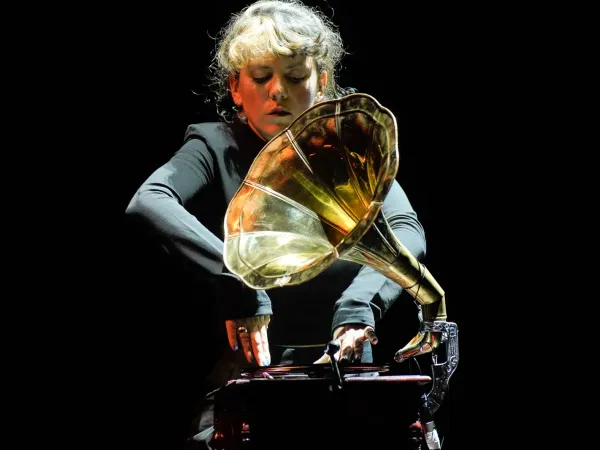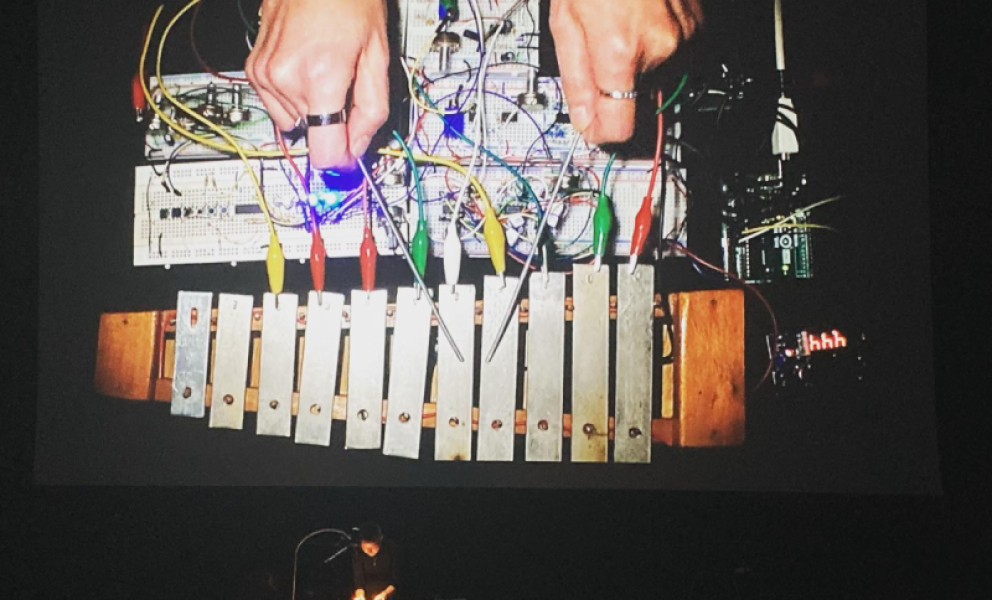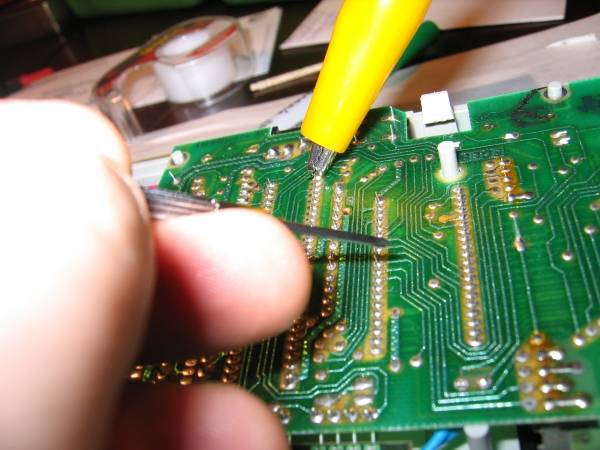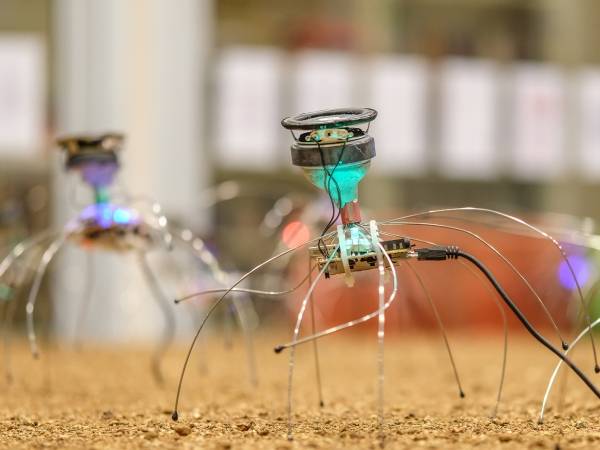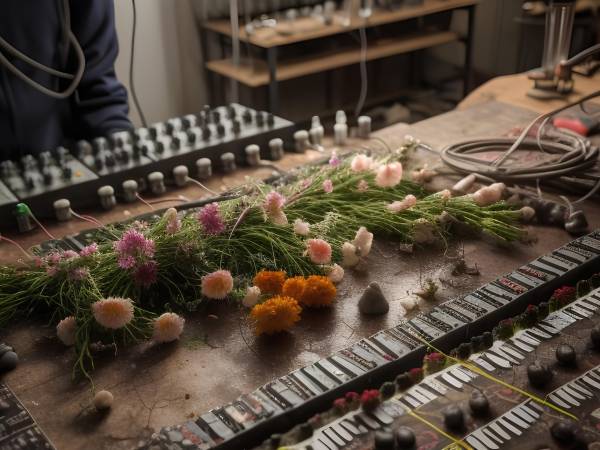7 Minuten
In the performance of music, various elements can shape the perception of the audience present. First of all, of course, the sound is at the center, the focus of attention. However, perception is also significantly influenced by questions of physical, spatial, material, and temporal circumstances. What means are used to produce the sound? Who is the person producing the sound? What is the significance of this specific interaction between people and objects? Who acts, and makes decisions, and how are these decisions carried out? These questions can easily be ignored in a traditional concert situation, as centuries-old conventions often make questioning them seem superfluous. In many experimental and contemporary musical practices, however, these questions need to be asked and renegotiated. In the performance of music in which no playing musicians are present, or in which newly developed instruments are used; in which the computer is used as an instrument, the source of the sound production is not necessarily visible and the roles of composer and performer become more fluid, makes this seem necessary. In this article, I would like to take a closer look at the artistic practices of composers and sound artists Estelle Schorpp and Ji Youn Kang to try to shed light on individual approaches within the spectrum of these questions. In doing so, I would first like to ask about the relationship between the perception of visible and invisible elements of musical performance.
What is invisible? What is visible?
Or: What is present? What is perceived? Sound itself can be visualized, but it is not visible. It can be perceived acoustically. It is the act of sound production, or certain parts of it, that are visible. Visible are the bodies of instrumentalists and singers, their movements and touches, interactions with instruments. The instruments themselves, their materiality, their mechanics. Their position in the space, the spatial constellations and relationships, light, and the spatial relationship to the audience. The extent to which these individual elements are perceived superficially depends on a multitude of interdependencies. This pushing of individual elements into the foreground can be described as presence. Something or someone is present and a special focus is placed on this presence. Paradoxically, this can also apply to the absence of a thing or a person when the listener is expected to be present. The sound is therefore always a trace of a presence, the result of an event.
In acousmatic music, in which there are no musicians or performers on stage and in which the music is conveyed purely via loudspeakers, sounds can also create a presence in the room. Here, for example, we can think of the intimate voice recordings in the tape pieces by Luc Ferrari or Robert Ashley, which sonically project a specific physicality into the listening space. The listener cannot see the body to which the voice belongs. But the sound of the voice alone can say so much about the body that an image of it is created. The loudspeakers that convey the sound are visible in this case, but they fade into the background as a purely mediating medium.
Loudspeakers are technical devices that are intended to reproduce sound on the one hand and can also be regarded as instruments on the other. They trigger the sound, their materiality makes it possible to hear and perceive the sound. However, their material properties as objects and their specific timbres are often ignored to force a supposedly neutral sound reproduction, regardless of its playback medium.
In the performance of music with acoustic instruments, standardized performance practice and the design of the concert situation often prevent an emphasis on the presence of the performers, their instruments, and their interaction.
In the following, I would like to look at two recent works by female composers whom I hold in high esteem and in whose work I see a very individual approach to working with sound-generating objects, in which the presence and materiality of these objects and the physical interaction with them are negotiated.
Interaction and manipulation
A conversation between a partially educated parrot and a machine (2023) – Estelle Schorpp | La Biennale di Venezia 2023
A gramophone stands illuminated on an otherwise dark stage. A woman steps onto the stage and cranks the gramophone. A male voice plays a record and explains, intermittently, what we are about to hear: Recordings of birds, the first ever made. We hear the Latin names and European names of the birds, carefully explained. Noise. The bird calls fly through the audience, spread across several loudspeakers as they move through the room. The sounds are distorted and noisy due to the way they are played and the aging process of the technology. The materiality of the record and the needle scratching on it is abundantly clear. In the course of the performance, the performer and composer of the piece, Estelle Schorpp, will interact with the record on the sensor-equipped gramophone, moving it and modulating the sound. The noisy sounds of the birdcalls take on a new quality, changing and repeating themselves in ever-changing sections. In another part, Schorpp will change her position on stage, move to a stand with two tablets, and manipulate the sounds more obviously digitally via her touch.
Both the birds and the man speaking are not present, their voices were recorded a long time ago. Their sound, their movement, and the memory character of the sound give them a presence in the room. The performer is physically present, she interacts with the emblematic gramophone, this ancient object that reproduces the recorded sounds and at the same time imposes its own age and a specific sonic identity on them. Her movements are precise and determined. Schorpp is pursuing an intention that does not always refer to the usual use of a gramophone. Nevertheless, the movements are oriented towards the form and function of the object and can be linked to the perceived reaction of the sound to the interaction. Schorpp's interactions with the object are not the movements of an instrumentalist who becomes one with the instrumental sound body, but those of a composer who wants to produce certain sounds together with the object.
Becoming part of the instrument
Ji Youn Kang often works with self-built instruments made of electronic components. She builds circuits from analog components to find out how these parts work together and how their function can be manipulated and subverted. In her piece "Cross-wired Xylophone", she combines various such circuits with the bars of a xylophone. This must be played or touched to close the circles and create or change the sound. First, she connects the individual bars of the instrument to various parts of the circuits using colorful cables. These lie open and fragile in front of her, you can see every component, also because everything is projected oversized onto the wall behind her, many small cables, and flashing lamps whose function is not exactly recognizable. Kang impulsively touches the bars of the instrument with thin, metal mallets. Instead of the expected metallic, resonant sound of the xylophone, we hear an analog oscillating sound that does not resonate, but stops immediately when contact with the bars ends. Her movements are initially cautious but determined. She begins to alternate the beats for rhythmic impulses with continuous scratching on different bars. The oscillations slow down and speed up, become modulated, and change their sound components. Putting the mallets aside, Kang begins to touch the bars directly with her hands and connect different bars with each other. The realization comes quickly: it is her touch, her body, that closes the circuits, it needs the touch as a bridge to create the sound. The electricity, invisible and noiseless, needs a physical connection and must be conducted through a body. The body and the interaction therefore not only trigger the sound, but their mass, their resistance are necessary and decisive for the creation of the sound. Kang therefore intervenes directly in the sound with her body, becomes part of the instrument, and can thus manipulate the sounds. The xylophone as a percussion instrument undergoes a physical and tonal expansion, and the performer's interaction with this instrument takes on a special significance. In the further course of the piece, she will use different constellations of her hand movements and other mallets, which change the sounds through various touches and connections. To introduce the end, she places loose bars from another xylophone on the keys, connects them via the metal material, and removes her body from the instrument as a component. Connected in this way, the instrument continues to play on its own.
Bodies and objects are present
... and they are integral components of the composition and performance of these two works. Schorpp and Kang both augment and manipulate these very specific sound-producing objects, one a device for the reproduction of music, the other a musical instrument, in which the already existing instrumental character is intensified precisely through this interaction. The instruments are understood as objects with a specific materiality, a history, and as triggers of certain expectations and associations, the understanding and fulfillment or non-fulfillment of which is worked with. The composers as performers interact with these objects in an unusual and specific physical way, creating and changing sound that shapes the connection between the presence of these bodies and objects. In this way, the visible determines the presence of the hidden, the invisible, and the sound.
Leonie Strecker
Leonie Strecker is a composer and sound artist. She works with the possibilities of the symbolic and semantic nature of sound, combining live performance and acousmatic sound to create hybrids of concert music, performance, and installation. In her works, which often work with spatial audio systems, the use of the voice as a means of sound production and as a way of incorporating text and a sense of human presence is a central element. Strecker's work includes electro-acoustic music as well as works for soloists and ensembles. Her works have been performed at festivals such as Musikprotokoll (AT), La Biennale di Venezia (IT), Audio Art (PL) and Time Canvas (BE), as well as at venues such as Kunstpalast Düsseldorf (DE), Kunstsammlung NRW (DE), De Singel Arts Centre Antwerp (BE), and ZKM Karlsruhe (DE).
Article topics
Article translations are machine translated and proofread.
Artikel von Leonie Strecker
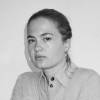 Leonie Strecker
Leonie Strecker 